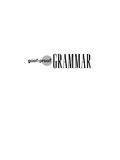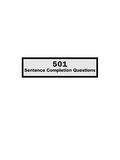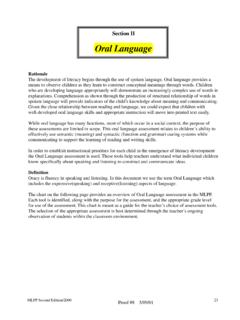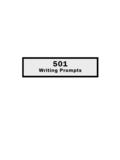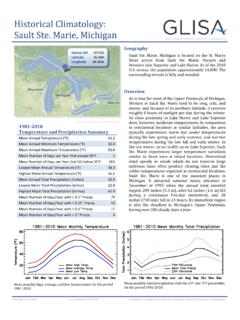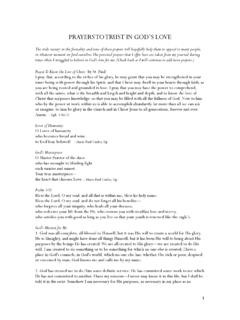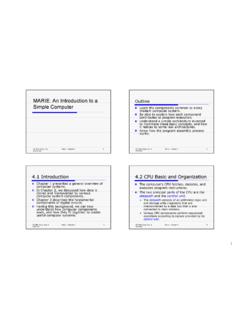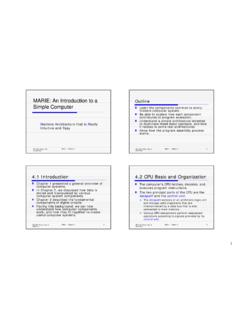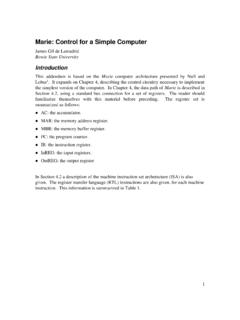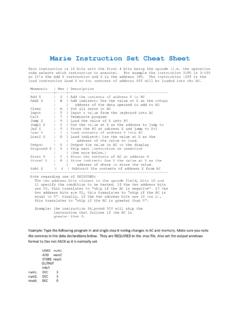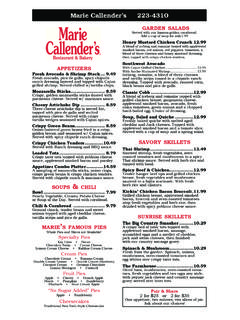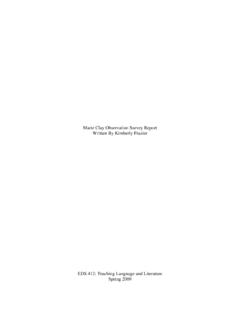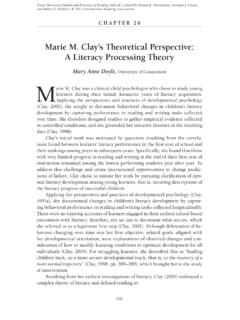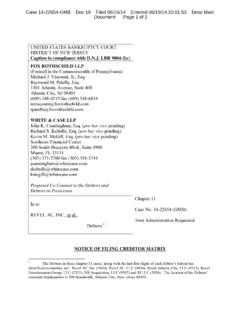Transcription of Concepts of Print - Macomb Intermediate School …
1 1 PROCEDURE 1. The assessment area should be quiet and free from major distractions. Generally, a small table where the teacher can sit beside the child is sufficient. 2. Preview the prompts for the Concepts of Print Assessment. Mark locations in the book where you will ask specific questions. (Note: Using post-it notes labeled with question numbers will make the task easier. This will make it possible to move smoothly through the book reading the test to the child and asking the appropriate question when the opportunity arises.) Write anecdotal observations of students behaviors as they use the book. 3. The chart Concepts of Print Teacher s Words gives the teacher s words for each section of the assessment.
2 Begin by giving a text to the student. Be sure to hold the text by the spine of the book so you will avoid guiding the student in the use of the book. 4. Place a check ( ) in the column for a correct response. Place a (l) in the column for an incorrect or no response. Record the incorrect response in the comments column. 5. If the child struggles with the tasks on the Concepts of Print Assessment, discontinue and finish reading the book to the child. Make the experience a positive one. 6. Total the number of correct responses and record in the score box. Notes: Sometimes children become confused about book, Print , and reading Concepts as they are learning. Reassessing some children on the entire Concepts of Print assessment may be warranted, especially if a child is making slower progress than you would expect.
3 It is not necessary, however, to re-administer the entire Concepts of Print assessment to every child. For some children it is sufficient to re-administer only the sections on which the child has difficulty. ANALYSIS Analyze the child s correct and incorrect responses along with your observations of the child s behavior about book features to determine Concepts of Print strengths and areas of instructional strategies. The teacher may use the italicized Concepts to help in the analysis of the child s performance. Begin analysis by categorizing the child s response by concept . If the teacher found that a child had difficulty with the concept of letter, the next level of analysis would be to generate several questions about the child s performance.
4 Are the errors the child made due to the form of the letters ( font style or size), the language that was used in describing the letters, ( capital rather than big letters), or was the difficulty in the child s understanding of the spatial positioning of the letter ( first, last). Realize that the two prompts used for punctuation marks are quite different (name or function). Did the use of one prompt affect the student s performance? The grid will help guide the teacher s instructional decisions. A hierarchy in teaching Concepts of Print is book Concepts , directionality Concepts , reading Concepts , concept of letter and word, and punctuation marks. Concepts of Print 2 Concepts of Print Teacher s Words No.
5 Concepts Prompts Responses/Scores 1. FRONT COVER (Book Concepts ) Show me the front of this book. One point for correct response. 2. BACK COVER (Book Concepts ) Show me the back of this book. One point for correct response. 3. THE TITLE (Book Concepts ) Show me the name of this book or story. One point for pointing to title on cover or title page. 4. Print CARRIES THE MESSAGE (Reading Concepts ) Show me where I start reading. One point for Print . Zero points for picture. 5. BEGINNING OF TEXT (Directionality Concepts ) Show me with your finger where I have to begin reading. One point for pointing to the first word. 6. LEFT TO RIGHT; TOP TO BOTTOM (Directionality Concepts ) Show me with your finger which way I go as I read this page.
6 One point for moving left-to-right on page with finger. 7. RETURN SWEEP (Directionality Concepts ) Where do I go then? One point for return sweep (top line to bottom line). 8. ONE-TO-ONE MATCH (Reading Concepts ) You point to the words while I read the story. (Read slowly, but fluently). One point for one-to-one matching of Print with spoken word. 9. FIRST WORD ( Concepts of Word) Use your finger to show me the first word on this page. One point for pointing to the first word on the page. 10. LAST WORD ( Concepts of Word) Use your finger to show me the last word on this page. One point for pointing to the last word on the page. 11. WORD ( Concepts of Word) Move your fingers until I can see one word.
7 Now, show me two words. One point for BOTH correct responses. Continued on next page. 3 Concepts of Print Teacher s Words Continued No. Concepts Prompts Responses/Scores 12. FIRST LETTER IN A WORD ( Concepts of Letter) Show me the first letter in a word. One point for correct response. 13. LAST LETTER IN A WORD ( Concepts of Letter) Show me the last letter in a word. One point for correct response. 14. ONE LETTER/TWO LETTERS ( Concepts of Letter) Move your fingers and show me one letter. Now, show me two letters. One point for BOTH correct responses. 15. LETTER NAMES ( Concepts of Letter) Show me three letters that you know on this page and tell me the name of each one. One point for pointing and correctly naming three letters.
8 16. A CAPITAL LETTER ( Concepts of Letter) Use your finger to show me a capital letter. One point for pointing to or framing a capital letter. 17. A SMALL LETTER ( Concepts of Letter) Use your finger to show me a small letter. One point for pointing to or framing a small letter. 18. PERIOD (.) (Punctuation Marks) What is this called? or What is this for? One point for naming and/or demonstrating an understanding of what a period means. 19. QUESTION (?) (Punctuation Marks) What is this called? or What is this for? One point for naming and/or demonstrating an understanding of what a question mark means. 20. EXCLAMATION(!) (Punctuation Marks) What is this called? or What is this for?
9 One point for naming and/or demonstrating an understanding of what an exclamation point means. 21. QUOTATION ( ) (Punctuation Marks) What is this called? or What is this for? One point for naming and/or demonstrating an understanding of what a quotation mark means. 22. COMMA (,) (Punctuation Marks) What is this called? or What is this for? One point for naming and/or demonstrating an understanding of what a comma means. 4 Concepts OF Print Individual Checklist Student Name: _____ Grade as of May, 2001: _____ District: _____ Date Administered: _____ Recording: Indicate correct responses with a check ( ). Write (l) if the child cannot or will not give a response. The student POINTS to: Score Comments 1.
10 The front of the book 2. the back of the book 3. the title 4. the text 5. where to begin reading the story 6. the direction in which to read (left to right) 7. where to go next at the end of the line 8. words one-to-one as teacher reads one page (voice- Print matches) 9. the first word on the page 10. the last word on the page The student FRAMES: 11. one word/two words 12. the first letter in a word 13. the last letter in a word 14. one letter/two letters 15. The student points to and names any three letters on the page (___ ___ ___). The student points to OR frames: 16. a capital letter 17. a small letter 18. a period (.) 19. a question mark (?) 20.

